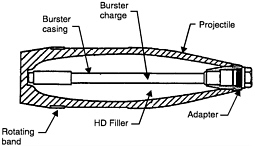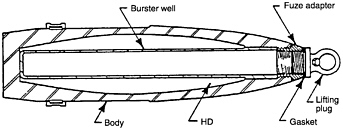Appendix A
Description of Munitions in the Pueblo Chemical Depot Stockpile
Figures A-1 through A-3 are cutaway drawings of the 105-mm shell, 155-mm shell, and 4.2-inch mortar projectiles. Information is also included on the size, weight, energetics, and packaging of each projectile.
The stockpile inventory at Pueblo Chemical Depot consists entirely of munitions containing mustard agent. Most of the projectiles contain mustard agent HD (distilled ß,ß'-dichloroethyl sulfide). Some contain mustard agent HT, a 60:40 eutectic mixture of HD and bis(2-[2-chloroethylthio]ethyl)ether. All of the munitions may contain some degradation products and inorganic residues.
REFERENCE
U.S. Army. 1977. Army Ammunition Data Sheets: Artillery Ammunition, Guns, Howitzers, Mortars, Recoilless Rifles, Grenade Launchers, and Artillery Fuzes (FSC 1310, 1315, 1320, 1390). TM 43–0001–28. April 1977. Washington, D.C.: Headquarters, U.S. Army.

|
M60 Cartridge, 105-mm Howitzer |
|||
|
Length |
31.1 inches |
Booster |
M22 |
|
Diameter |
105 mm |
Explosive |
Tetrytol |
|
Total weight |
42.92 lb |
Explosive weight |
0.3 lb |
|
Agent |
HD |
Propellant |
M67 |
|
Agent weight |
2.97 lb |
Propellant weight |
2.83 lb |
|
Fuze |
M557/M51A5 |
Primer |
M28A2/M28B2 |
|
Burster |
M5 |
Packaging |
1 round/fiber container, 2 container/wooden box |
FIGURE A-1 105-mm howitzer projectile. Note: M60 105-mm cartridges have been reconfigured and therefore will not have propellant attached. Source: Adapted from U.S. Army, 1977.

|
M110 Projectile, 155-mm Howitzer |
|||
|
Length |
31.1 inches |
Booster |
M22 |
|
Diameter |
155 mm |
Explosive weight |
0.41 lb |
|
Total weight |
94.6 lb |
Propellant |
None |
|
Agent |
HD |
Propellant weight |
None |
|
Agent weight |
11.7 lb |
Primer |
None |
|
Fuze |
None |
Packaging |
8 rounds/wooden pallet |
|
Burster |
M6 |
|
|
FIGURE A-2 155-mm howitzer projectile. Source: Adapted from U.S. Army, 1977.

|
Cartridge, 4.2-inch Cartridge/Mortar |
||
|
|
M2/HT |
M2A1/HD |
|
Length |
21.0 inches |
21.0 inches |
|
Diameter |
4.2 inches |
4.2 inches |
|
Total weight |
24.67 lb |
24.67 lb |
|
Agent |
HT |
HD |
|
Agent weight |
5.8 lb |
6.0 lb |
|
Fuze |
M8 |
M8 |
|
Burster |
M14 |
M14 |
|
Explosive |
Tetryl |
Tetryl |
|
Explosive weight |
0.14 lb |
0.14 lb |
|
Propellant |
M6 |
M6 |
|
Propellant weight |
0.6 lb |
0.4 lb |
|
Primer |
M2 |
M2 |
|
Packaging |
1 round/fiber container, 2 containers/wooden box |
1 round/fiber container, 2 containers/wooden box |
FIGURE A-3 4.2-inch mortar cartridge. Note: 4.2-inch cartridges/mortars will be reconfigured as projectiles. Most 4.2-inch cartridges will also be defuzed. Source: Adapted from U.S. Army, 1977.




